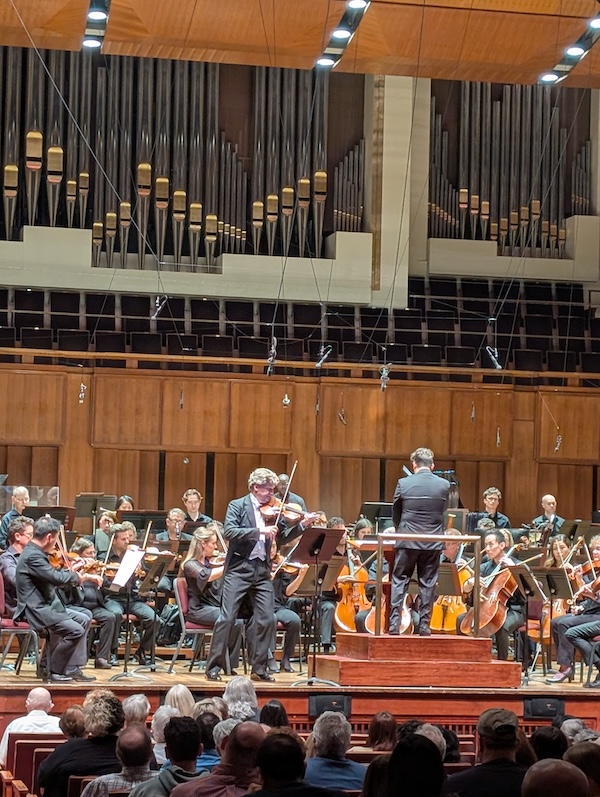Classic film music outshines concerto premiere with NSO

James Ehnes was the soloist in the world premiere of James Newton Howard’s Violin Concerto No. 2 with James Gaffigan conducting the National Symphony Orchestra Thursday night at the Kennedy Center. Photo: C. Downey/WCR
The National Symphony Orchestra offered a survey of music from American movies Thursday night, part of the Kennedy Center’s Notes & Frames film music festival. James Gaffigan, general music director of the Komische Oper Berlin, returned to the Concert Hall podium for the first time since 2023. The world premiere of a new Violin Concerto by James Newton Howard, with James Ehnes as soloist, served as centerpiece.
The most successful film composers have mostly been those with extensive training in and knowledge of classical music history. This was certainly true of Austrian composer Erich Korngold, a child prodigy and accomplished adult. Born into a Jewish family, he fled the Nazi regime in the 1930s and settled in Los Angeles, where he helped create the vocabulary of American film music in Hollywood.
In the Overture to The Sea Hawk, a 1940 naval adventure film starring Errol Flynn, the NSO brass played the many grand fanfares in the opening section with swashbuckling vivacity. The violin section and other strings glowed ardently in the soaring love themes of the middle section, before the fanfare music returned.
Aaron Copland compiled his suite Music for Movies from three of his film scores in 1942. The NSO woodwind section evoked the peaceful countryside with exquisitely tuned lines in the first movement. This music and the more dynamic third movement (“Sunday Traffic”) were composed for The City, a documentary about the new type of civic life created right outside the nation’s capital in a utopia called Greenbelt, Maryland.
Gaffigan, a conductor who leads as much with his dancing body as with his crisply defined beat, helped the NSO create distinct moods in each of the movements. The second movement, from Of Mice and Men, had a down-home simplicity to it, while the repeating motif outlining a G major chord captured the innocence of Thornton Wilder’s Our Town. Gaffigan’s confidence at the podium guided the biting, mechanical accents of the last movement, a depiction of threshing machines in Of Mice and Men.
James Newton Howard, who turned 74 earlier this week, has scored films directed by Christopher Nolan and M. Night Shyamalan, among many others. The NSO commissioned his Violin Concerto No. 2 for James Ehnes, who also premiered the composer’s first Violin Concerto in 2015. The new piece falls into the standard three movements, with tempi arranged fast-slow-fast and adding up to a little more than twenty minutes of music–“more of a pop concerto,” as the composer himself put it in his program note.
Ehnes initiated a near-constant run of sixteenth notes in the first movement, which the orchestra joined gradually. A more lyrical contrasting theme intervened briefly, but the main idea of the movement, those percolating sixteenth notes, remained dominant. The greatest success came in the slow movement, with Ehnes’ low-set solo sounding over gloomy cellos, moving later into the high range for Ehnes to round out an ardent, tragic aria.
Agitation returned in the third movement, with jagged violin writing over a walking bass line, punctuated by occasional big blares of brass and some joyous music reminiscent of a hoedown. A brief violin cadenza featured some lyrical double-stop writing, some of the most complex music in the piece, before a cinematic finish.
Still, overall Howard’s new concerto felt somewhat episodic, with engaging ideas in each movement that did not get developed into anything more substantial. As an encore, Ehnes offered something more profound, the affecting Largo from Bach’s Solo Violin Sonata No. 3.
Italian composer Nino Rota, near the end of an illustrious career scoring the films of Federico Fellini, Luchino Visconti, and Franco Zeffirelli, created iconic music for Francis Ford Coppola’s The Godfather. A suite assembled by Riccardo Muti offered a selection of music from the first and second films in the trilogy, complete with characteristic touches of mandolin, accordion, and twangy upright piano. Assistant principal trumpeter Michael Harper excelled in the famous trumpet solo.
Leonard Bernstein’s Symphonic Suite from On the Waterfront rounded out these highlights of the American cinema. The French horn solos proved solid and heraldic, the emblem of this 1952 film directed by Elia Kazan about violence and corruption among longshoremen in Hoboken. Assistant principal flutist Leah Arsenault Barrick brought a poignant beauty to the delicate solo, accompanied by harp, that represents the fragility of Edie, played so beautifully by Eva Marie Saint in the film. It is a shame that Bernstein did not compose other film scores, apart from the movie versions of his musicals.
The program will be repeated 8 p.m. Friday and Saturday, with different concertos replacing the Howard piece: Michael Abels’s Delights and Dances and John Williams’ Horn Concerto, respectively. kennedy-center.org
